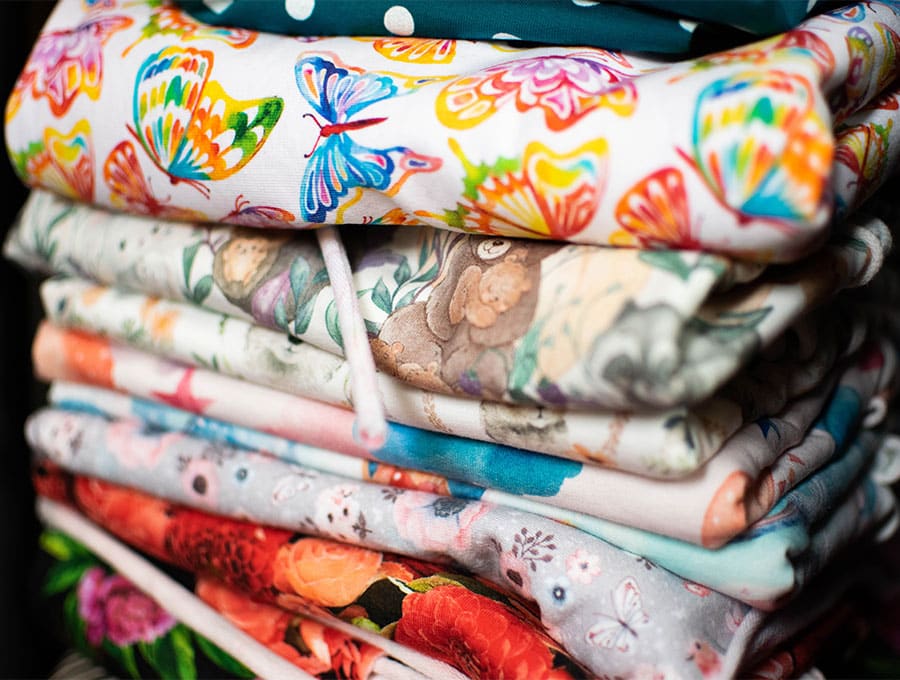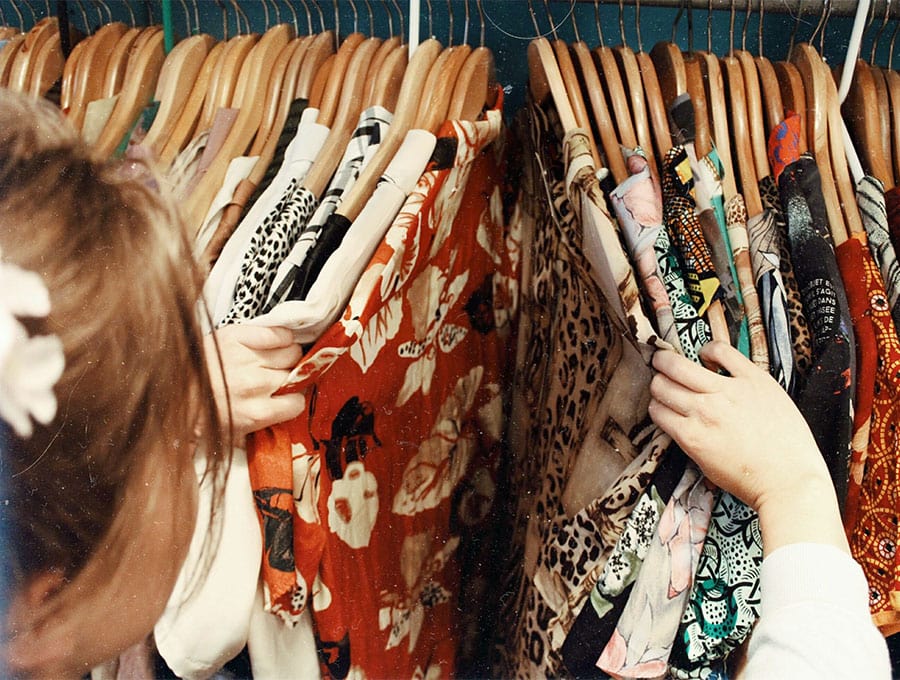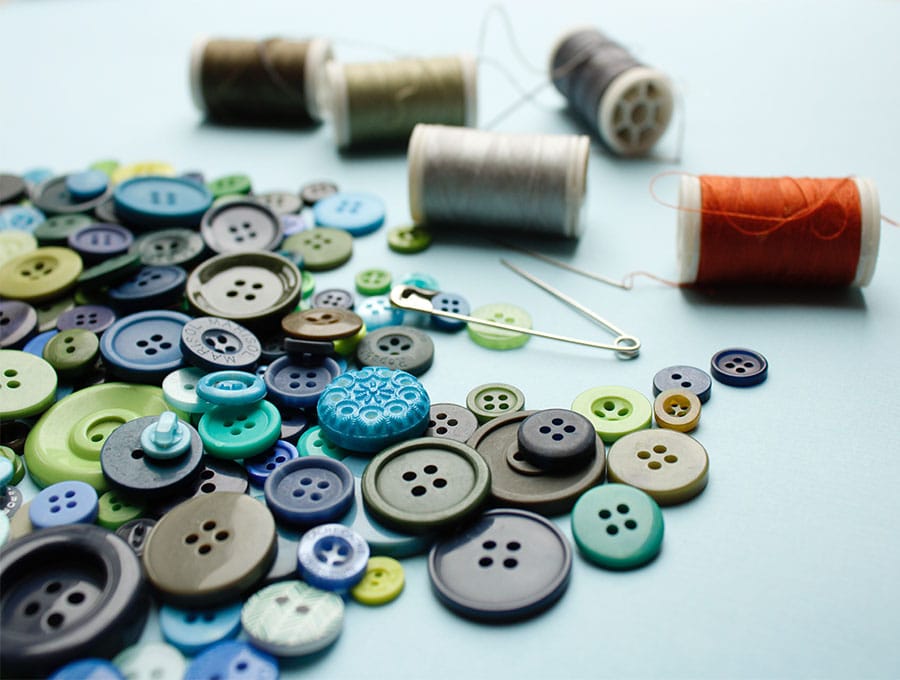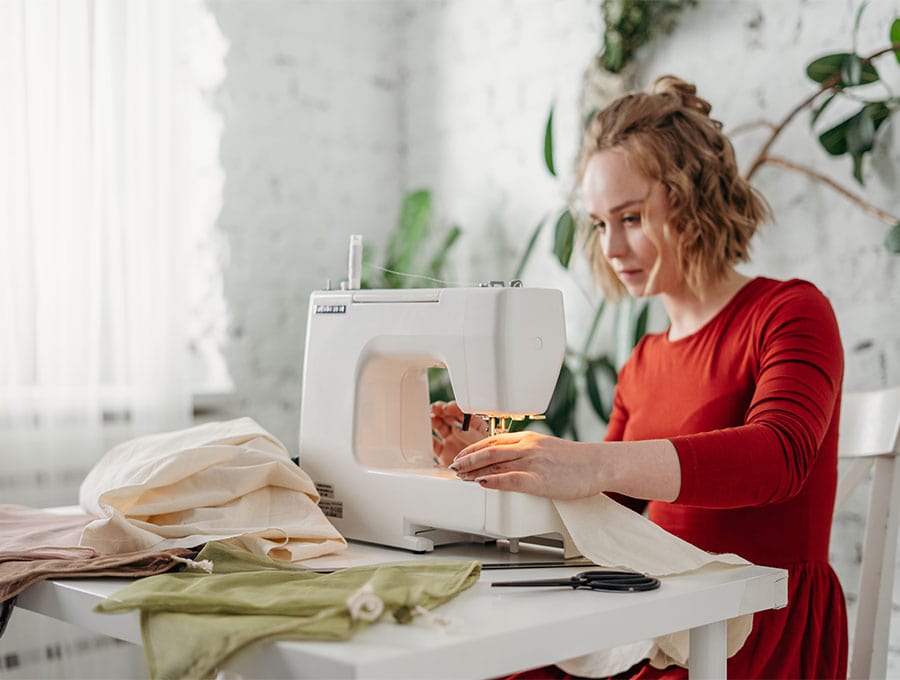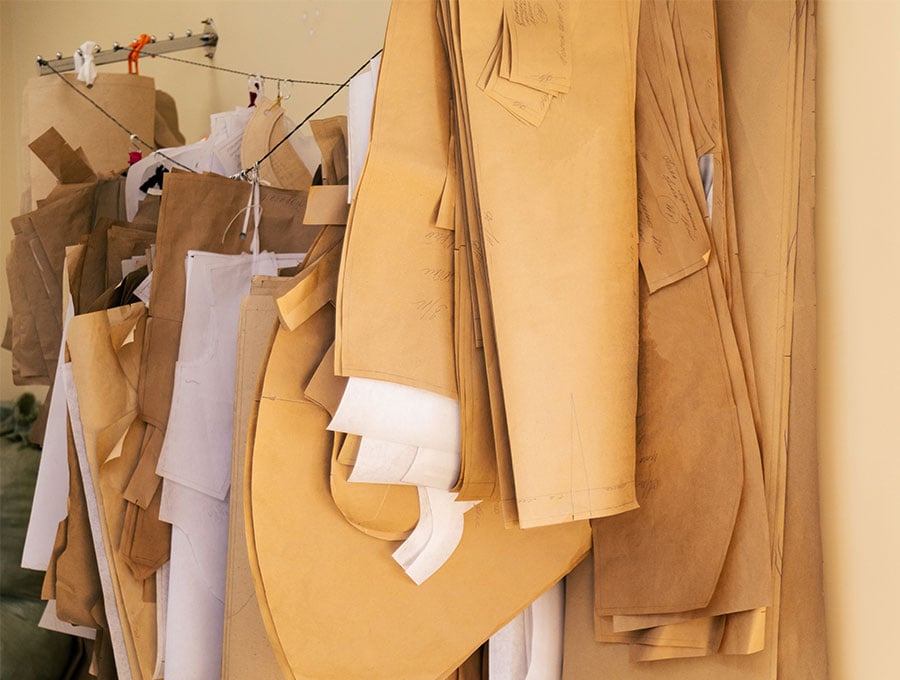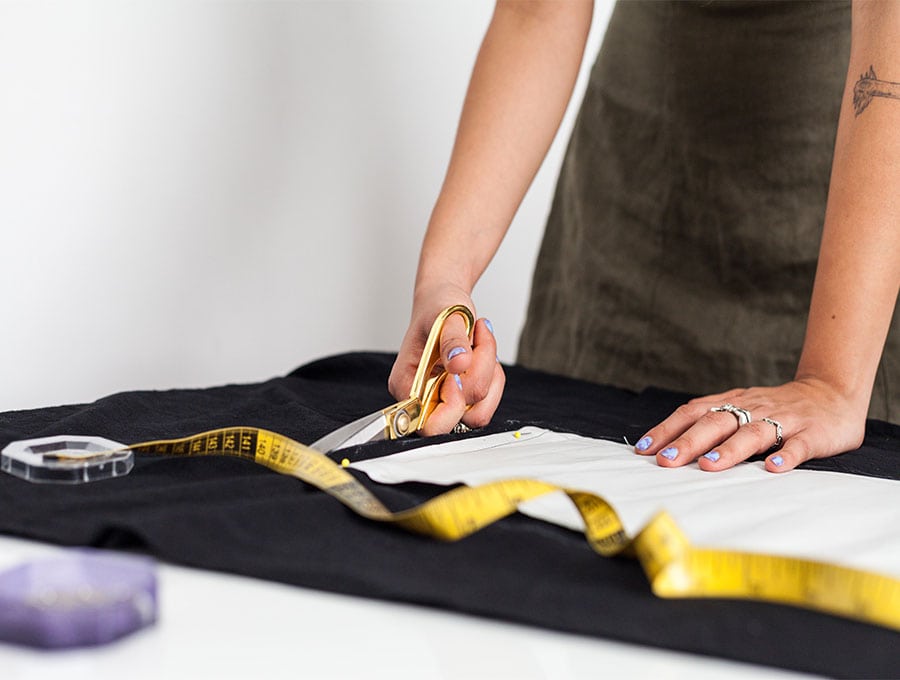26 Ways to Save Money While Sewing
Sewing is good for you, according to the experts! Being able to sew is a skill that gives you a sense of achievement and pleasure in creating, which releases dopamine, the feel-good hormone, plus encourages neuron connections, keeping your mind more active. Sewing can help relieve stress and prevent dementia as a person ages. When you sew, you have to remember a specific sequence of steps that will help keep your mind focused and active.
Besides the mental health benefits, you can feel pride when you step out in a new outfit and people comment on your style or the finish of the garment. The only problem is that sewing can get expensive if you are not careful about buying, storing, and using your fabrics and trimmings. We have set out 26 ways to help you save money while sewing.
Table of Contents
- 1 1. Organize your fabric stash
- 2 2. Organize accessories
- 3 3. Buy elastic in bulk
- 4 4. Order zippers in bulk lots
- 5 5. Examine your stash before buying
- 6 6. Bundle fabric purchases
- 7 7. Word of mouth works
- 8 8. Thrift shops
- 9 9.Tablecloths, bed sheets and duvet covers
- 10 10. Check your wardrobe
- 11 11. Recycle unfinished projects
- 12 12. A little goes a long way
- 13 13. Avoid stashing the color of the season
- 14 14. Buy only what you need
- 15 15. Sales and remnants
- 16 16. Save buttons and zippers
- 17 17. Concentrate on smaller items
- 18 18. Save your free patterns
- 19 19. Repurpose patterns
- 20 20. Establish a system for storing patterns
- 21 21. Make your patterns
- 22 22. Sell your creations
- 23 23. Save on presents by making stuff.
- 24 24. Join a sewing group
- 25 25. Cut single layer
- 26 26. Maintain your equipment
1. Organize your fabric stash
Too often, we forget what we have because it’s not stored according to a system. I like to use clear plastic boxes with roller wheels and snap-close lids. This means I can see what is inside each box, keep the fabric free from dust and organize material according to type – lightweight summer fabrics, winter weight items, upholstery fabric, Lycra, satins, etc. Each box is clearly labeled at the short end and stored on shelving, making it easy to pull out. I haul out the Lycra box if I want to make swimwear or a fitted fancy dress costume. Summer inspiration? Out comes the summer fabric box.
2. Organize accessories
Sort your zippers, buttons, and other findings by type and color in clear plastic zip lock bags and store them in labeled containers. My pet hate is digging through a box where zippers, trims, and braids all get tangled with each other. Even my cotton is organized in a big flat box by color in rows – all the shades of red from maroon to cherry red, pinks from the palest to deep cerise, and so on, so I can match a color to a fabric at a glance.
3. Buy elastic in bulk
Regarding trimmings and findings, buy by the roll rather than the yard or meter – but only if you know you will use all you buy. For example, if you have young kids and know you will make lots of boys’ pants, girls’ skirts, and pajamas, it is worth buying your elastic by the 25m roll rather than by the meter. For a start buying one yard or meter of elastic for a garment leaves you with a piece over, which is often not enough for the next garment. Buying buy the roll means no wastage as you cut just what you need, and the bulk price is way lower.
4. Order zippers in bulk lots
If you will be sewing several makeup bags, pencil cases, or cushion covers, it saves to buy zippers in bulk. A grey or neutral will go with most colors – it is not necessary to perfectly match the zip to the garment color unless you are doing high-end special occasion outfits.
5. Examine your stash before buying
When you have a new project that is relatively small, then check your stash first for something suitable rather than going straight out to buy or order something online. I know – all those beautiful fabrics online are so tempting. But resist. First, use what you have, sell a few items, then you can splash out.
6. Bundle fabric purchases
Try to buy fabric for various projects at once to save on delivery costs, rather than ordering one or two yards or meters here and there several times a month.
7. Word of mouth works
Make sure everyone you know is aware that sewing is your hobby. I mean everyone from your hairdresser to colleagues, friends, and all family members. That way, if anyone wants to make you a gift for your birthday or Christmas can do so. Here’s a handy list of gifts for sewists you can pass on. Or if someone is de-stashing or knows someone who is, they can inform you early. Many people chuck out perfectly usable flannel bedsheets, tablecloths, and fabric offcuts that could be repurposed. If they know your hobby, they are more likely to pass them your way – free of charge so they can declutter!
8. Thrift shops
These are not only a source of fabric offcuts that others have donated, but you can find perfect garments and reuse the fabric for another item. Particularly worthwhile are the evening dresses, often made from gorgeous materials that you can buy for just a couple of dollars and cut to make beautiful little princess dresses and fairy costumes. When repurposed, men’s check shirts can make cute pants and tops for toddlers.
9.Tablecloths, bed sheets and duvet covers
Often these are thrown out because of one stain somewhere on the fabric – otherwise, the item is still in good condition – so use the fabric for various projects. Let friends and family know you need some fabric to repurpose if they declutter their linen cupboards. Old sheets are suitable for making a test garment to check for fit before cutting expensive fabric.
10. Check your wardrobe
You may have clothing items with that are no longer fashionable which can be cut and used for various projects.
11. Recycle unfinished projects
Most sewists have that embarrassing basket or box of unfinished projects. The style may need to be updated if it is a fashion garment. If it was a kid’s item, they might have outgrown it before you even got to make it. Don’t despair – sort through the projects and save the fabric for new things you may want to make in the future.
12. A little goes a long way
When it comes to gorgeous beaded and embellished fabrics, you don’t have to make the whole garment from wildly expensive material – an eye-catching cuff, collar, or pocket will look classy and make that costly fabric go a long way. You can even do a yoke or applique an expensive fabric to something that is otherwise quite plain. Success depends on how well you integrate the costly fabric and combine colors so it looks like a designer one-off.
13. Avoid stashing the color of the season
Peach may be in this season, but it will be out next year. Then your fabric lies there for years. If you are keen to stock up on linens, for instance, then go for white, neutral, or black. These are timeless classics.
14. Buy only what you need
It is tempting to say, “Oh, I’ll have a yard of that and a yard of this.” Instead, ask the assistant the minimum yardage the shop will sell and determine precisely how much you need. You may only need a ¼ yard if it is a small project. The extra fabric will sit around for a long time waiting for a suitable project – tying up money you could have used in the short term. If it is a tiny bit of fabric you need, see if something in your stash will do instead for the project. Simply because an illustration uses a particular color combination doesn’t mean you can’t pick your colors.
15. Sales and remnants
If you need lining or backing fabric, then by all means, buy these and whatever other material you need on sale, but don’t fall prey to a buying frenzy where you buy it just because it’s cheap, but you don’t need it. End-of-season and end-of-roll sales can yield some bargains, but you want to avoid tying up too much cash in the dead fabric you probably won’t use for a few years.
If an item is about to be turned into cleaning cloths, cut off the buttons, and if the zippers are any good, remove those carefully. It will save you from having to go off to buy these items.
17. Concentrate on smaller items
Start with smaller projects to gain skills and develop confidence in your sewing, meaning you’ll spend less on fabric. Once you are a confident sewist and are ready to go for the bigger ticket items, like evening wear, or dance costumes, you’ll have the knowledge, so there is less likelihood of a failed project. Quilters can start on cushions and bags, which can be sold before progressing to the double bed size quilts, which can cost quite a bit in supplies. By then, you may have built a quilting cotton stash to incorporate into the bigger projects.
18. Save your free patterns
There are many free patterns online, from small projects to designer dresses. For example, here at HelloSewing.com I provide hundreds of free sewing patterns as well as roundups of other designers’ patterns. Many designers will supply one free pattern online as a taster; then, you must buy the others. Save these and label them – always number the pattern pieces and write the pattern’s name on each piece. Then write the total number of pattern pieces on the label of the envelope or file pocket where you store them. If one part is missing, you can figure out which one is gone and maybe locate it if it was misplaced when you were working on multiple projects.
19. Repurpose patterns
If you buy a commercial pattern, you can always use it more than once. Make sure to make one item in print and another in plain fabric – people won’t realize it’s the same pattern. You can also change the length of sleeves and hemlines, cut a slightly different shape neck, and even combine pieces from different patterns – a different sleeve or a straight skirt instead of a flared skirt. When combining like this, it is advisable to do a test run using old cotton sheets or muslin to check the look and feel of the garment before cutting expensive fabric.
20. Establish a system for storing patterns
The better your filing system for the patterns, the easier you can access a type. For example, you may need something for a baby shower or newborn – then you go to the “Baby pattern” file or box. Accurate pattern filing will save you time and money wasted on buying duplicate or similar patterns to what you already have.
21. Make your patterns
You will save a fortune if you learn to cut off the pattern from a garment. If the garment is worn out and due to be dumped, pick it apart, lay out the pieces on paper, and trace around them, marking where the darts or pleats, if any, are placed. Observe the grain of the original fabric pieces on your paper pattern – the correct grain is essential for a good fit for a garment.
For simple garments that are still being worn, you can fold the garment to trace around the front and back of the garment, creating your pattern. Teenagers’ mini-skirts, as are sleeveless tops and simple sun dresses, are a breeze to make. It is essential for an excellent fit to try to use a similar fabric to the original material because the original pattern designer will take the material’s weight and drape into account.
22. Sell your creations
You can set up your website selling items or place goods on Etsy or eBay, but maintaining your site can be time-consuming, and sites like Etsy are pretty competitive, so you will need to find a unique niche. A Facebook or Instagram page can be helpful if you are selling to friends, family, and followers. Finding craft stores that take goods on consignment can get you started. The other alternative is to sell at markets. If you dislike being out there on weekends or haven’t the time with a young family, you can combine with a few friends or like-minded sewists and hire someone between you to run the stall. You can put your income towards more sewing projects.
Here’s some ideas of sewing projects that sell well
23. Save on presents by making stuff.
Instead of buying presents, you can save half and more of the cost you usually spend on a makeup bag, shopping bag, scrunchie, etc., and gift them. I always have a stash of ready-made scrunchies (made from leftover strips of fabric) ready to gift. Cosmetic bags, crossbody bags, shopping bags, sunglasses cases, and passport covers are always useful.
Here are more gift ideas you can sew!
24. Join a sewing group
It can be an online group, a group that meets up in your area, or even a couple of colleagues who enjoy sewing. This way, you can swap patterns, learn tips and techniques from each other, and even trade remnants of fabric from projects which someone else may need. You can share the names of places with great deals and buy in bulk online, so the yardage and delivery costs are lower. Companies give a much better price per roll than per yard or meter.
25. Cut single layer
Pattern layouts on commercial patterns always overestimate the yardage because pieces are cut in double layers. By cutting a single layer, you can save a lot of fabric – you just need to be careful not to cut two left sleeves or two left fronts. Once you have cut one pattern piece, you lay it over the fabric according to the grain, with the wrong sides facing each other.
26. Maintain your equipment
Your sewing machine and serger (overlocker) represent quite an investment, as do quality scissors. Ensure they are covered when not in use to prevent dust and rust. Check oil levels in your machines regularly and use those brushes they came with to clean out the little compartments within the machine to keep them free of lint. This will help prevent a machine motor from suddenly seizing and the costly outlay to replace a motor. If yours is not an industrial machine, run it for a short period, which can result in overheating. Domestic machines are not meant to be run for 8 hours a day. Scissors need to be kept in a fabric scissor pouch and given a little oil now and again. Also, train your family that sewing scissors are NOT craft scissors and are under no circumstances to be used to cut paper.
Remember that saving money on sewing doesn’t have to mean sacrificing creativity or style. By adopting some of the money-saving tips we’ve discussed, you can make sewing a more affordable hobby that brings joy and satisfaction. Whether you’re a seasoned sewist or just starting out, there are always ways to cut costs without sacrificing quality. With a little ingenuity and resourcefulness, you can create beautiful, one-of-a-kind pieces that reflect your personal taste and flair.



